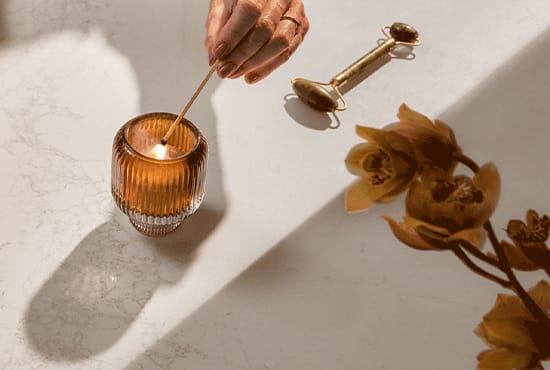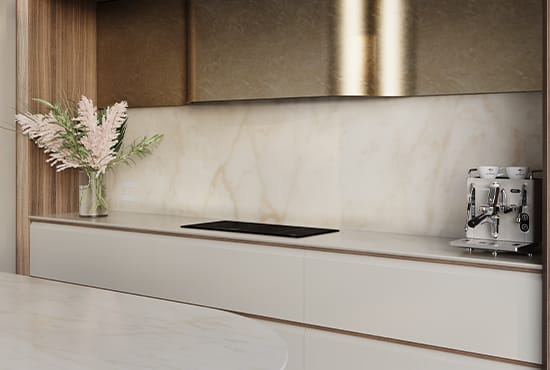
Surface Evolution
Caesarstone’s ongoing commitment to safety,
service and the continuous development of market-leading surfaces
In light of the Australian Federal Government’s announcement to ban engineered stone containing crystalline silica from July 1 2024, we wanted to assure you of our ongoing commitment to safety, our dedication to customer service, as well as the continuous development of market-leading surfaces.
We understand this government decision has created some uncertainty. Our aim is to help inform everyone so you can feel confident with your choice of surface, now and into the future.
Firstly, no matter the Caesarstone® surface you have in your home, we can assure you it is completely safe. It is in the fabrication process where stonemasons, if not following correct safety procedures, can be exposed to fine crystalline silica particles.
In the transition period, from now until 1 July 2024 the sale and installation of mineral surfaces, including our extensive low silica range will continue. However, there are several matters that remain to be resolved by the Government, including clarification on existing contracts being installed after 1July 2024. It is also important to note that not all states and territories are aligned on the timings of the transition period. We will provide updates as soon as we get further information.
As part of our commitment to continuous innovation, we are implementing a plan to transition our current, market-leading design collection to a new crystalline silica-free formulation which will retain the same ease of fabrication and functional performance characteristics as current materials. This new material will launch in Australia in the first half of 2024.
In addition, Caesarstone® will introduce new designs into our Porcelain collection in the first half of 2024. Our Porcelain brings additional functional performance to kitchen benchtops as well as being UV resistant and suitable for both indoor and outdoor applications.
Every Caesarstone® surface has a lifetime warranty, which is not impacted by these changes.
Explore more colours and our health & safety initiatives
Surface Evolution
FAQs
What is X-Ray Diffraction Analysis (XRD) ?
X-ray diffraction analysis (XRD) is a technique used in materials science to determine the crystallographic structure of a material.
In Caesarstone’s case we use XRD testing to certify that our material adheres to Government regulations of trace levels less than 1% Crystalline Silica.
Where can I find test results for Mineral Crystalline Silica-Free?
Caesarstone have engaged with NATA an Australian accredited laboratory to complete XRD testing on our Caesarstone Mineral™ Crystalline Silica-Free slabs.
Test certification can be found here as new colours become available the relevant test certification will be uploaded accordingly.
FAQ Is engineered stone banned in Australia?
Come 1st July 2024, engineered stone will no longer be sold in Australia.
(Subject to final government decisions we believe contracts entered into prior to December 13th, 2023, will be able to be supplied any of the Caesarstone collection) .
Leading up to this date, the sale and installation of engineered stone will continue and post July 1, Caesarstone will offer Caesarstone Mineral™ Crystalline Silica Free surfaces for applications such as kitchen benchtops. Along with the Caesarstone Porcelain collection of surfaces ideal for a variety of applications within your home including kitchen benchtops, bathrooms, laundries and outdoor dining areas.
Read more about the the ban on engineered stone here.
Is my family safe if I have a crystalline silica surface in my home?
No matter the Caesarstone® surface you have in your home, we can assure you it is completely safe. It is in the fabrication process where fabricators, if not following correct safety procedures, can be exposed to fine crystalline silica particles.
If I damage a crystalline silica surface in my home, can it be repaired?
Yes. Caesarstone® partners with third-party suppliers to repair minor damages. If a benchtop requires removal, it is safe to remove. There are no health risks from hazardous dust when safely removing, handling, transporting, storing, or disposing of benchtops. Further information about safe handling and removal can be found here.
What should I do if I renovate my kitchen (removing an existing engineered stone surface)?
It is safe to remove Caesarstone® benchtops and there are no health risks from hazardous dust when safely removing, handling, transporting, storing, or disposing of benchtops. Hazardous dust in concentrations that are dangerous to health is only created by the fabrication processes of benchtops, such as cutting, grinding, chipping, sanding, drilling, polishing, etc. These processes are not required in order to remove benchtops.
In the vast majority of cases, benchtops are removed by cutting the adhesive and removing the whole countertop in one piece. In rare and complex scenarios where the remover has no option but to break the benchtop at certain points for ease of removal, this must NOT be done with power tools that create hazardous dust.
As conditions and circumstances differ from site to site, Caesarstone® recommends wearing a dust mask (minimum P2 respirator mask) when removing, demolishing, disposing of or placing Caesarstone® quartz surfaces in skip bins.
For more information about the safe removal of existing benchtops please refer to our Removal Guide.
Will Caesarstone® honour its lifetime warranty on surfaces that are banned?
Every Caesarstone® surface has a lifetime warranty, which is not impacted by these changes.
What is the difference between crystalline silica and silica?
The most common form of crystalline silica is quartz, which is found in sand, gravel, clay, granite, diatomaceous earth, and many other forms of rock. Non-crystalline silica is found in glass, silicon carbide, and silicone.
What has Caesarstone® done to help ensure the safety of workers in the stone industry?
While the safety of workers has and continues to be our priority, the following are key milestones in Caesarstone’s history to create and communicate effective and uniform safety standards.
1996 – Updated Material Safety Data Sheets (MSDS).
2002 – Fabrication Manuals introduced to Fabricators including silica safety warnings.
2005 – Fabricators acknowledging and signing off on fabrication & safety manuals.
2010 – Communication to all fabricators discussing Silicosis. Issue of Health & Safety guide to all fabricators. Warning labels applied on all slabs.
2014 – Warning on invoices and delivery notes.
2016 onwards – National roadshows educating fabricators about industry safety.
2018 – Joined Qld &NSSW Government Taskforce on Health & Safety. Active involvement with Safe Work Australia. AESAG formed (Australian Engineered Stone Advisory Group).
2019 – Participated in a parliamentary enquiry and later again in 2022.
2019 onwards – Introduced CS Connect to give fabricators more control
2020 – Employed a full-time EHS leader to drive our national health & safety, culture and programs
2020 onwards – Worked with the National Dust Disease Taskforce.
2021 – Launched Master of Stone, an online certification program for all fabricators. Worked with the Victorian state government and Deloittes on the Victorian Licensing scheme. 22 fabricator sessions were held to educate fabricators. 150 fabricators registered for Master of Stone in the first 6 months after its launch. Introduced low silica product.
2021 and ongoing – Our EHS leader continues to work one one-on-one with fabricators in Vic to assist with their licensing process.
2022 – 2391 fabricators completed Master of Stone online safety training program. Launching a free lung screening program for fabricators in collaboration with iCare using their mobile lung bus at our locations. Conducted 62 customer site safety visits. Participated in UNSW research study: Education and Communication to Prevent Silicosis. Formed part of the National Silicosis Prevention Strategy and National Action Planning Committee.
2023 – Launched MOS free online safety training program to the wider industry. Commitment to transition the entire portfolio to under 40% by the end of year. Achieved 14,000 completed safety training modules. Partners with KBDi to continue creating awareness on important industry-related topics.
How do we know in the future that crystalline silica-free surfaces won't be banned?
Nothing in the future is for certain. However, Silica is present in thousands of materials, many of which are used in building and construction daily e.g. bricks, concrete, tiles and sandstone. Banning all materials isn't a feasible solution to solving silica-related illnesses. To mitigate and manage the risk there needs to be sufficient worker education, uniform standards, monitoring, a licensing regime and robust enforcement by regulators for work on all products containing silica. Caesarstone® will continue to advocate for this to ensure the safety of all workers.

















